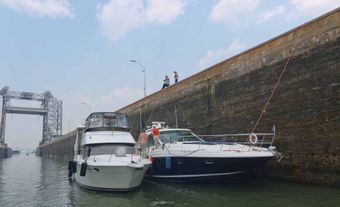The Trent-Severn Waterway system links Lake Ontario (at Trenton) with Lake Huron (at Port Severn on Georgian Bay). The water route (386 km long) utilizes the Trent River to Rice Lake, the Otonabee River, the Kawartha Lakes, constructed channels to lakes Simcoe and Couchiching, and the Severn River to Georgian Bay. The waterway consists of 44 locks, some 75 control dams, 15 swing bridges and 2 marine railways (at Big Chute). Two of the locks, at Peterborough and Kirkfield, are hydraulic-lift locks, which are unique in North America and among the highest in the world. Locks overcome a rise of 182 m to the summit at Balsam Lake and then a drop of 80 m to Lake Huron.
Early settlers constructed simple connections between some lakes to facilitate the floating of timber cut from nearby forests. Logging, milling, steamboating, grain handling and recreation were all linked to the development of the waterway. Work was sporadic and covered 87 years from 1833 to 1920. The length of time it took to complete the waterway indicates the reluctance of the various levels of government (British, colonial, provincial and federal) to build it. The waterway underwent a major modernization and reconstruction program in the 1960s, but some sections of the waterway remain largely unchanged from when they were first built.
Now under Heritage Canada, Parks Canada (since 1972), the waterway is used every summer for boating. It also plays a role in providing water for municipal supplies, hydroelectric-power generation, wildlife-habitat protection and flood control.

 Share on Facebook
Share on Facebook Share on X
Share on X Share by Email
Share by Email Share on Google Classroom
Share on Google Classroom
